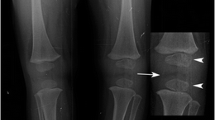Abstract
A skeletal dysplasia with previously unreported features is presented. Its evolution was characterized by growth abnormalities of bones without involvement of other organs. Advanced bone age, increased stature and irregular epiphyseal ossification with stippling of the main long bones were documented. Physeal overgrowth was massive in the left proximal humerus and femur. Furthermore, the hip joint appeared fused with an abundant mass of pathological calcific tissue extending from the femur to the ilium. Pathological epiphyses were characterized by anarchic cartilaginous proliferation with multiple ossification centres, while lamellar bone apposition and remodelling were normal. The observed bone changes were different from those in any previously reported syndrome, metabolic defect or bone dysplasia. However, they clearly indicated a defect of endochondral ossification with some resemblance to phenotypes observed in dysplasia epiphysealis hemimelica.






Similar content being viewed by others
References
Silverman FN (1996) Reflections on epiphyseal dysplasias. AJR 167:835–842
Fairbank TJ (1956) Dysplasia epiphysialis hemimelica (tarso-epiphysial aclasis). J Bone Joint Surg Br 38B:237–257
Azouz EM, Slomic AM, Marton D et al (1985) The variable manifestations of dysplasia epiphysealis hemimelica. Pediatr Radiol 15:44–49
Carlson DH, Wilkinson RH (1979) Variability of unilateral epiphyseal dysplasia (dysplasia epiphysealis hemimelica). Pediatr Radiol 133:369–373
Kettelkamp DB, Campbell CJ, Bonfiglio M (1966) Dysplasia epiphysealis hemimelica. A report of fifteen cases and a review of the literature. J Bone Joint Surg Am 48:746–766
Merzoug V, Wicard P, Dubousset J et al (2002) Bilateral dysplasia epiphysealis hemimelica: report of two cases. Pediatr Radiol 32:431–434
Poznansky AK (1994) Punctate epiphyses: a radiological sign, not a disease. Pediatr Radiol 24:418–424
Silverman FN (1989) Dysplasia epiphysealis hemimelica. Semin Roentgenol 24:247–258
Acknowledgements
The authors are grateful to Prof. A. Benetti, Morbid Anatomy Department, University of Brescia, for processing tissue samples and for useful discussions during preparation of this article.
Author information
Authors and Affiliations
Corresponding author
Rights and permissions
About this article
Cite this article
Pazzaglia, U.E., Beluffi, G., Marchi, A. et al. Poly-epiphyseal overgrowth: description of a previously unreported skeletal dysplasia. Pediatr Radiol 37, 1025–1030 (2007). https://doi.org/10.1007/s00247-007-0532-z
Received:
Revised:
Accepted:
Published:
Issue Date:
DOI: https://doi.org/10.1007/s00247-007-0532-z




